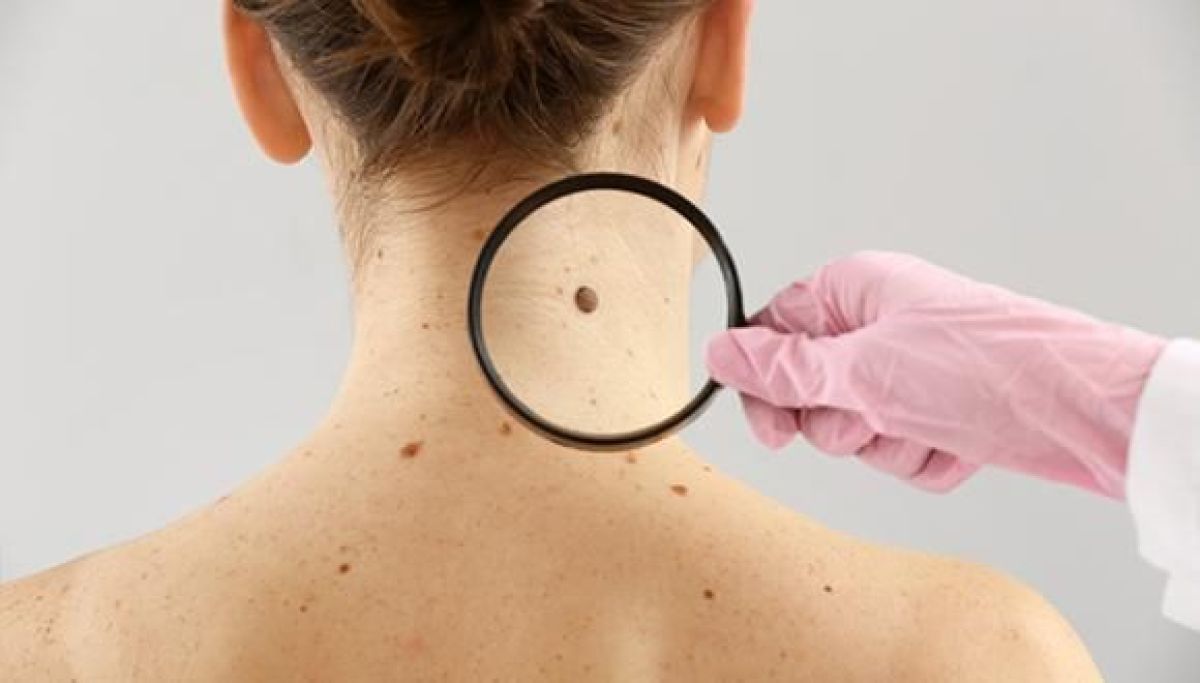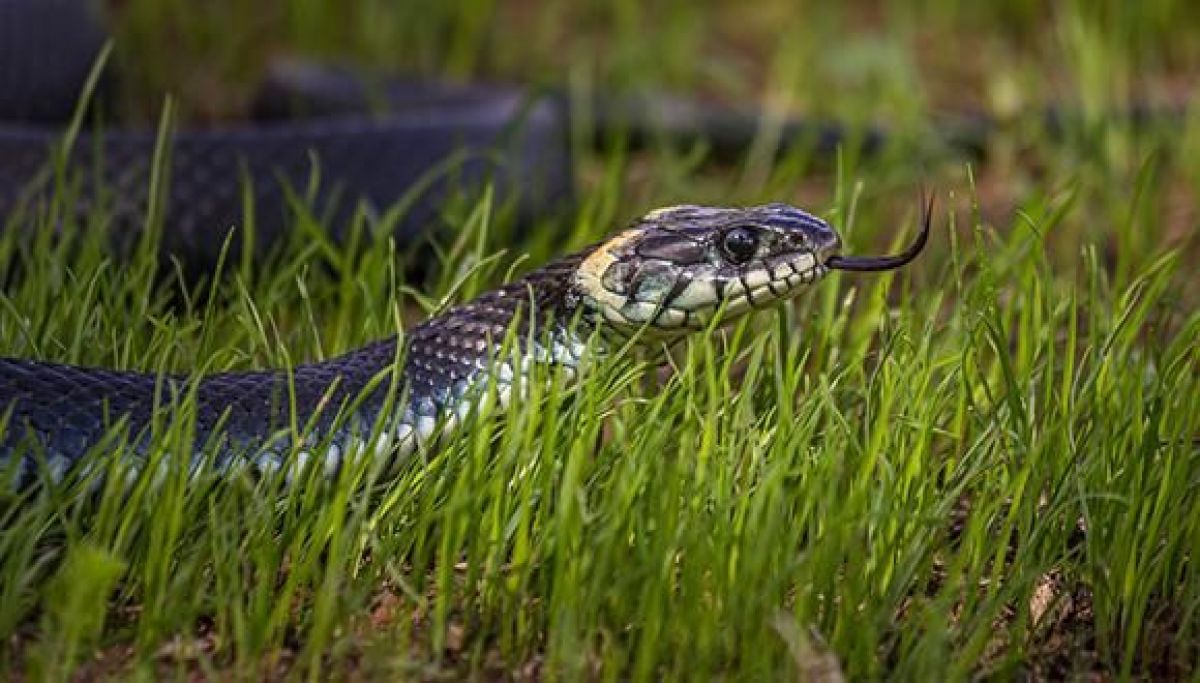Author: AUFTAU
British Variant 45% More Contagious than Original Virus
According to TAU study, based on data from 300,000 tests for Covid-19.
A new study at Tel Aviv University found that the British variant (termed: B.1.1.7) of Covid-19 is 45% more contagious than the original virus. The researchers relied on data from about 300,000 PCR tests for Covid-19 obtained from the COVID-19 testing lab, which was established in collaboration with the Electra Group. According to the researchers, “The study proves that active monitoring of at-risk population and prioritized vaccination programs can prevent hundreds of deaths.” The new study was conducted by Prof. Ariel Munitz and Prof. Moti Gerlitz of the Department of Clinical Microbiology and Immunology at the Sackler Faculty of Medicine, together with Dr. Dan Yamin and PhD student Matan Yechezkel from the Laboratory for Epidemic Modeling and Analysis (LEMA) at the Department of Industrial Engineering, all at Tel Aviv University. The study’s results were published in the prominent scientific journal Cell Reports Medicine. The Electra-TAU laboratory was established in March 2020, right after the outbreak of the first wave of the pandemic in Israel. To date, it has analyzed hundreds of thousands of tests from all over the country – from public drive-in test facilities, as well as programs targeting specific populations – such as ‘Shield for Fathers and Mothers’ which routinely ran tests in at-risk hotspots like retirement homes. Prof. Ariel Munitz explains: “We use a kit that tests for three different viral genes. In the British variant, also known as B.1.1.7, one of these genes, the S gene, has been erased by the mutation. Consequently, we were able to track the spread of the variant even without genetic sequencing.” According to Prof. Munitz, the data from the lab shows that the spread of the British variant in Israel was very rapid: On December 24, 2020 only 5% of the positive results were attributed to the British variant. Just six weeks later, in January 2021, this variant was responsible for 90% of Covid-19 cases in Israel. The current figure is about 99.5%. “To explain this dramatic increase, we compared the R number of the SARS-CoV-2 virus with the R of the British variant. In other words, we posed the question: How many people, on the average, contract the disease from every person who has either variant? We found that the British variant is 45% – almost 1.5 times – more contagious.”Vaccine Saved Hundreds
In the second stage of the study, the researchers segmented contagion by age groups. The results indicated that the turning point for the 60+ population compared to other age groups occurred two weeks after 50% of Israel’s 60+ population received their first vaccine shot: “Until January we saw a linear dependence of almost 100% between the different age groups in new cases per 1,000 people,” says Dr. Dan Yamin. “Two weeks after 50% of the 60+ population received the first dose of the vaccine this graph broke sharply and significantly. During January a dramatic drop was observed in the number of new cases in the 60+ group, alongside a continued rise in the rest of the population. Simply put, since more than 90% of those who died from Covid-19 were over 60, we can say that the vaccine saved hundreds of lives – even in the short run.”Active Monitoring of At-Risk Populations
Moreover, the new study proves that active monitoring of at-risk populations works. “There is a threshold value for determining whether a specific test is positive or negative for the virus – with a lower value indicating a higher viral load,” says Prof. Munitz. “When we compared the threshold values of the different genes in 60+ residents of retirement homes with the values measured in 60+ persons in the general population, we saw significantly higher values in the retirement homes. This means that the viral load in retirement homes was lower compared to the rest of the population. Since the residents of retirement homes are tested routinely, while other people are usually tested only when they don’t feel well or have been in contact with someone who had tested positive for the virus, we conclude that constant monitoring of at-risk populations is a method that works. It is important to emphasize: the relatively low viral load was found in retirement homes despite the fact that the British variant had already begun to spread in all populations. Consequently, we show that monitoring retirement homes, together with vaccination that gives precedence to vulnerable populations, prevent illness and mortality.” Dr. Yemin concludes: “Due to crowded conditions, large households and age distribution in the Israeli population, the coronavirus had a more favorable environment for spreading in Israel compared to most Western countries. Our message to the world is that if with our problematic starting point a distinct decline was identified, other Western countries can certainly expect the curve to break – despite the high contagion of the British variant – with a dramatic drop in severe cases following the vaccination of 50% of the older population, alongside targeted testing at risk epicenters.” Featured image: Left to Right: Prof. Ariel Munitz, Dr. Dan Yamin and Prof. Moti GerlitzOptical Technology Generates Immediate Melanoma Diagnosis
Expected to revolutionize the field of skin cancer diagnosis.
Melanoma is a life-threatening cancer, but its immediate diagnosis can save lives. An innovative optical technology that can distinguish between different types of cancer has now been developed in the laboratory of Professor Abraham Katzir, from the Raymond and Beverly Sackler Faculty of Exact Sciences at Tel Aviv University, which enables real time diagnosis of melanoma. Based on special optical fibers, the technology will enable every dermatologist to determine the character of a suspicious lesion automatically, and particularly if it is melanoma. Non-invasive, immediate, and automatic, this process may lead to a dramatic change in the field of diagnosing and treating skin cancer, and possibly other types of cancer as well. The technology has been tried successfully on about one hundred patients in a major hospital in Israel. The findings were published in the Journal Medical Physics.Seeing Skin Cancer’s True Colors
When a suspicious lesion is found on the skin, during a routine examination, it is removed in a minor surgical procedure and sent to a laboratory for testing. A pathologist diagnoses the lesion and determines whether it is melanoma. In most cases where melanoma is discovered early, when it is still superficial and less than one-millimeter-thick and it is removed, the patient recovers. Late diagnosis, when the melanoma is more than one-millimeter-thick, significantly reduces the chances of recovery and is life-threatening. “The idea that guided us in developing the technology was that in the visible range, there are various substances, having various colors, which are not characteristic of each substance. On the other hand, in the infrared region, various substances have different ‘colors’ of a sort, depending on the chemical makeup of each substance,” says Professor Katzir. “Therefore, we figured that with the help of devices that can identify these ’colors’, healthy skin and each of the benign and malignant lesions would have different ’colors’, which would enable us to identify melanoma.” Professor Katzir’s research group developed special optical fibers that are transparent in the infrared. The group, in collaboration with physicists Professor Yosef Raichlin of Ariel University, Dr. Max Platkov of the Negev Nuclear Research Center, and Svetlana Bassov of Professor Katzir’s group, developed a system, based on these fibers, in accordance with the requirements of evaluating skin. The researchers connected one end of this type of fiber to a device that measures the ’colors’ in the infrared, and touched the other end lightly, for several seconds, to a lesion on a patient’s skin. The fiber made it possible to check the ’color’ of the lesion right away. Clinical trials were then carried out on suspicious lesions in about one hundred patients. With the help of the new system, physicists performed measurements of the ’color’ of each lesion, before it was removed and sent to a pathology laboratory. The researchers showed that all of the lesions that were determined by pathologists as being of a certain type, such as melanoma, had a characteristic ’color’ in the infrared. Each type of lesion had a different ’color’. “The technology gives us a kind of ‘fingerprint’, which makes it possible to diagnose the various lesions by measuring their characteristic ’colors’”, says Professor Katzir. “In this way, lesions can be diagnosed using a non-invasive optical method, and the physician and the patient receive the results automatically and immediately. This is unlike the test that is routinely used, which involves surgery, and the pathological diagnosis takes a long time.” Following the success of the study, the researchers plan to confirm the evaluation method on hundreds of patients.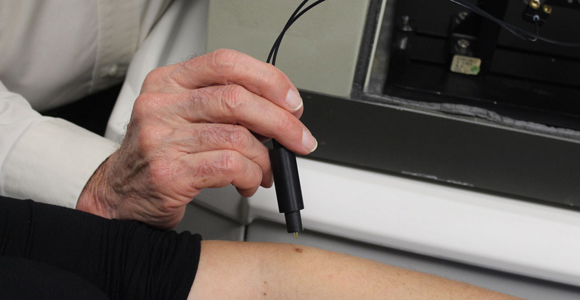
Non-invasive, immediate, and automatic
In conclusion, Professor Katzir says: “Melanoma is a life-threatening cancer, so it is very important to diagnose it early on, when it is still superficial. The innovative system will enable every dermatologist to determine the character of a suspicious lesion automatically, and particularly if it is melanoma. This system has the potential to cause a dramatic change in the field of diagnosing and treating skin cancer, and perhaps other types of cancer as well. The challenge will be to make this technology, which is still expensive, something that will be used in every hospital or clinic.”Gut Healing
TAU researchers identify proteins that cause intestinal disease.
Swapping the Cannon for a Rifle
Intestinal diseases are caused by pathogenic bacteria that attach to our intestinal cells. Once attached, the bacteria use a kind of molecular syringe to inject intestinal cells with proteins called “effectors.” These effectors work together to take over healthy cells, like hackers that take over computer servers using a combination of lines of code. However, until now scientists have not known what protein combination it is that cracks the cell’s defense mechanisms. Now, the TAU researchers’ artificial intelligence platform has identified novel effectors in the bacteria, which have been experimentally tested and validated. Subsequently, laboratory experiments conducted in London successfully predicted the protein combinations that lead to the pathogenic bacteria taking over the intestines. “In this study, we focused on a bacterium that causes intestinal disease in mice, a relative of the E. coli bacteria that cause intestinal disease in humans, so as not to work directly with the human pathogen”, explains Ph.D. student Naama Wagner. “The artificial intelligence we created knows how to predict effectors in a variety of pathogenic bacteria, including bacteria that attack plants of economic importance. Our calculations were made possible by advanced machine-learning tools that use the genomic information of a large number of bacteria. Our partners in England proved experimentally that the learning was extremely accurate and that the effectors we identified are indeed the weapons used by the bacteria.” “Pathogenic bacteria are treated with antibiotics,” says Prof. Tal Pupko. “But antibiotics kill a large number of species of bacteria, in the hope that the pathogenic bacteria will also be destroyed. So antibiotics are not a rifle but a cannon. Moreover, the overuse of antibiotics leads to the development of antibiotic-resistant bacteria, a worldwide problem that is getting worse. Understanding the molecular foundation of the disease is a necessary step in the development of drugs that are smarter than antibiotics, which will not harm the bacterial population in the intestines at all. This time we discovered the effectors of gut bacteria that attack rodents, but this is just the beginning. We are already working on detecting effectors in other bacteria in an attempt to better understand how they carry out their mission in the target cells they are attacking.”Michal Bat Adam Receives Israel Prize for Film Art
Broke barriers to become one of Israeli cinema’s first directors.
The Israel Prize for Film Art was awarded this week – to Michal Bat Adam, a lecturer at TAU’s The Steve Tisch School of Film and Television, who has written and directed 13 full sized movies, among them: “Moments“ (1979), “The Lover” (1985), “A Thousand and One Wives” (1989), “Aya: Imagined Autobiography” (1994), Love at Second Sight (1999), Life Is Life (2003), Maya (2010), The Road to Where (2016) and more. In addition, Bat Adam has starred in numerous movies, plays and on TV. She starred in many films by her late husband, Moshe Mizrahi, such as: “I Love You, Rosa” (1972), “The House on Chelouche Street” (1973) – both of which were nominated for an Oscar in the ‘foreign-language film’ category – “Daughters, Daughters” (1973), and Madame Rosa (1977), which won the Academy Award for Best Foreign Language Film. Two years ago, Bat Adam was awarded the Ophir Award for Lifetime Achievement (2019). The Ophir Award is colloquially known as the Israeli Oscars or the Israeli Academy Awards – awards for excellence in the Israeli film industry awarded by the Israeli Academy of Film and Television The Israel Prize committee said in a statement that, “Michal is a groundbreaking artist in Israeli cinema for five decades…[E]ven in a low-budget reality, at a time when there were still no government funds that supported filmmaking moviemaking as is customary today, Bat Adam has, over the years, produced 12 additional full length films that constitute a unique and original cinematic space. Her fruitful and meaningful film career is a significant inspiration for creators who dream of working in cinema.” Bat Adam is a director, screenwriter and actress committed to a unique, female cinema – uncompromising and groundbreaking. As an inspiring teacher and creator, she continues to influence the students at the school, as well as creators in Israel and around the world. Tel Aviv University, the Faculty of Arts and the School of Film and Television congratulate Michal on receiving the award and wish her continued productive work. featured image:An Underwater Salute to Grandma Vera
Marine biologist names new species of sponge after Holocaust survivor grandmother, turning 95.
There are many ways to make a beloved grandmother feel special on her birthday, and Tal Idan, a doctoral student in Prof. Micha Ilan’s sponge lab at TAU’s School of Zoology, did something quite unconventional: She scientifically named a new sponge that she herself discovered, after her grandmother, Vera. And as Israel is observing the national Holocaust Remembrance Day (Yom HaShoa), Tal found her own way of eternalizing her grandmother’s identity as a courageous Holocaust survivor.Finding a Needle in a Haystack
The process leading up to the naming of a new species of animals is complex and lengthy, and the naming is considered the icing on the cake. Tal Idan researches sponges on the Israeli coast of the Mediterranean. Detecting and identifying new species for science is part of her research. “One of the benefits of working in deep waters and in new environments, is that there will always be new species – simply because these places have not yet been reached by anyone,” she explains. “There are a number of sponges that we have not yet been able to identify. These three, however, we discovered back in 2018, and since then we have been working to identify them.”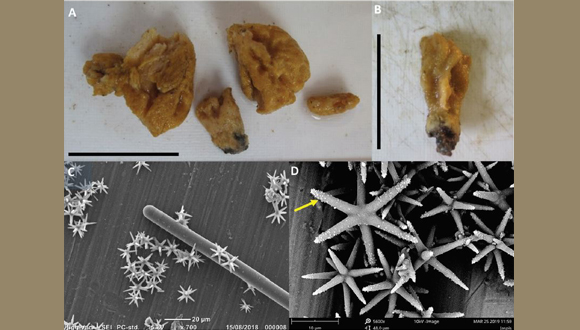 Vera the Sponge
Tal explains that this is a lengthy and intricate part. “Animal characterization is usually done by examining the genetic differences in the animals’ DNA. This won’t work with sponges, that have a really good DNA-repairing ability and their differences are not that big. One literally needs to characterize the structure of their body: “The skeleton of the sponges consists of skeletal needles in very beautiful shapes. You have to check the structure of the needles, measure and compare these to those of the other species that exist in the same genus. It took several years to produce good enough characterizations.”
Vera the Sponge
Tal explains that this is a lengthy and intricate part. “Animal characterization is usually done by examining the genetic differences in the animals’ DNA. This won’t work with sponges, that have a really good DNA-repairing ability and their differences are not that big. One literally needs to characterize the structure of their body: “The skeleton of the sponges consists of skeletal needles in very beautiful shapes. You have to check the structure of the needles, measure and compare these to those of the other species that exist in the same genus. It took several years to produce good enough characterizations.”
Grandma Vera’s Love for the Sea
Like Tal, Vera loves the sea very much. Throughout many years, Vera and her late husband, Otto, used to swim in the sea in all weathers. Otto was Vera’s childhood sweetheart from the Czech Republic, who survived the Holocaust with her and immigrated with her to Israel. Even after his death and up until very recently, Vera would continue to go to the sea alone.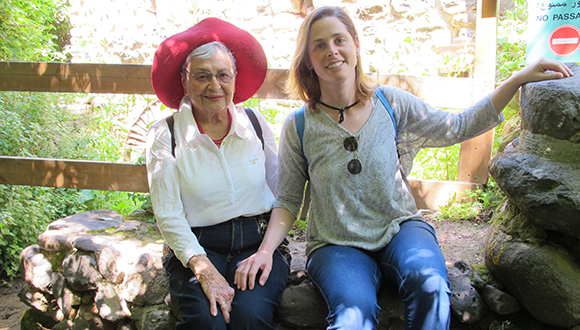 Tal and Vera, photographed during a trip in celebration of Vera’s 90th birthday
Tal and Vera, photographed during a trip in celebration of Vera’s 90th birthday
So far, Tal has successfully defined three new species for science. After consulting with her research colleagues, they decided that one of the sponges would be called Hemiasterella verai , named after grandma Vera. Tal explains that when a new species is named, it is common practice to include the origin of the name. Thus she was able to memorialize not only her dear grandmother’s name, but also the fact that she courageously survived the Holocaust. Tal says that it was important for her to do this for Vera while she is alive, and also to include this important fact.
Today, grandma Vera has three sons, seven grandchildren and 11 great-grandchildren, who all plan to attend her upcoming 95th birthday celebration. She always says they are her biggest victory over the Nazis.
Featured image: Tal Idan in the depths of the Mediterranean
Struggling in a Toxic Workplace?
TAU researchers hope to save farmers from snakebites in their fields.
Did you know that about 1.8 million instances of snakebite envenoming occur around the world annually, killing about 94,000 people? Snakebite envenoming is a potentially life-threatening disease that typically results from the injection of a mixture of different toxins (“venom”) following the bite of a venomous snake. In some areas, snakebites are considered a major cause of death, especially among farmers who encounter snakes in their fields. The World Health Organization has even launched a strategic plan to reduce snakebites by 50% by 2030. TAU researchers, as part of an international research group, created an innovative simulation model for predicting snakebites, based on an improved understanding of interactions between farmers and snakes.Mapping Snakebites
The purpose of the model is to determine the probability of a snakebites occurring in certain places (i.e. in rice fields vs. tea fields) at various times (hours of the day and months of the year). The study is founded upon extensive research and data from Sri Lanka, where about 30,000 envenoming snakebites kill roughly 400 people every year. It focused on 6 types of snakes – Cobra, Russell’s viper, Saw-scaled viper, Hump-nosed viper, Common krait and Ceylon krait – and the farmers who grow the 3 most common crops in the area: rice, tea and rubber. The model predicts that the bites of Russell’s viper, one of the world’s most dangerous snakes, peak in rice fields during February and August, while the less lethal hump-nosed viper prefers rubber plantations in April and May. It was also found that in the southeastern part of the studied region, the largest number of snakebites are inflicted by Russell’s viper, while in other parts of the region snakebites of the hump-nosed viper are the most common.Interdisciplinary Model
Eyal Goldstein of the TAU School of Zoology explains: “We built a first-of-its-kind interdisciplinary model, which includes the behavior patterns of both sides – snakes and humans, identifying risk factors at various times and places and warning against them. The model can for instance differentiate between low-risk and high-risk areas – a difference which can be manifested in double the number of snakebites per 100,000 people.”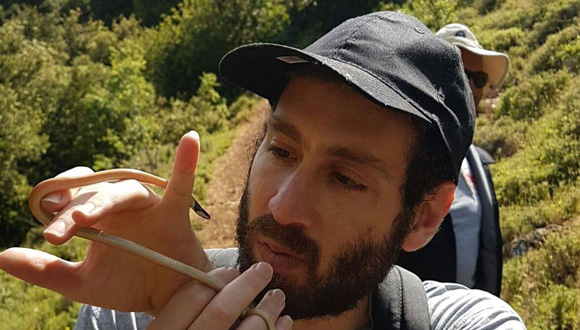 Eyal Goldstein
Dr. Kris Murray of Imperial College London and the School of Hygiene and Tropical Medicine in London explains that “Snakes and humans both go about their business at different times of the day, during different seasons and in different types of habitats. Our model factors in all these elements to predict encounters between humans and snakes in areas where farmers are working. We consider the degree of aggressiveness of different snake species when we calculate how likely an encounter is to result in a bite.”
Dr. Takuya Iwamura (currently at Oregon State University) emphasizes that “Our approach is to mathematically analyze interactions between snakes and humans, with an emphasis on the ecological perspective. This is a completely new approach to understanding the mechanism behind snakebites. Unlike most studies, which have so far focused mainly on social and economic risk factors, we chose to focus on the ecological aspects – such as snakes’ movements and habitats, the impact of climate and rainfall, and the respective behaviors of farmers and snakes – as a key to predicting potential encounters.”
Eyal Goldstein
Dr. Kris Murray of Imperial College London and the School of Hygiene and Tropical Medicine in London explains that “Snakes and humans both go about their business at different times of the day, during different seasons and in different types of habitats. Our model factors in all these elements to predict encounters between humans and snakes in areas where farmers are working. We consider the degree of aggressiveness of different snake species when we calculate how likely an encounter is to result in a bite.”
Dr. Takuya Iwamura (currently at Oregon State University) emphasizes that “Our approach is to mathematically analyze interactions between snakes and humans, with an emphasis on the ecological perspective. This is a completely new approach to understanding the mechanism behind snakebites. Unlike most studies, which have so far focused mainly on social and economic risk factors, we chose to focus on the ecological aspects – such as snakes’ movements and habitats, the impact of climate and rainfall, and the respective behaviors of farmers and snakes – as a key to predicting potential encounters.”
Scalable Model
About 1.8 million envenoming snakebites occur around the world annually, killing about 94,000 people. In tropical areas, especially in Southeast Asia and Sub-Saharan Africa, snakebites are considered a major cause of death, especially among farmers who encounter snakes in their fields. In response, the World Health Organization has launched a strategic plan to reduce snakebites by 50% by 2030. An important basis for attaining this goal is expanding relevant scientific research. Verified against existing data in Sri Lanka, the model was proved very accurate in predicting snakebite patterns in different areas and different seasons, as well as the relative contribution of various types of snakes to the overall picture as documented in hospital data. The researchers plan to implement the model in places that do not yet keep accurate snakebite data. They will also use it to predict future changes resulting from climate change – such as increased rainfall leading to greater snake activity, as well as changes in land use and habitats available to snakes. Dr. Iwamura concludes: “Our model can help focus the efforts of snakebite reduction policies, and serve as a tool for warning, raising awareness and saving human lives. We regard this study as a first stage in a broader project, and plan to develop more complex models of encounters between humans and wildlife, to support both public health and nature preservation policies in the real world.”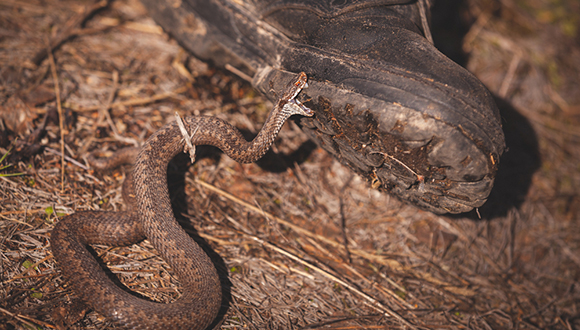 Farmer and snake – better off apart
The study was led by Dr. Takuya Iwamura (currently at Oregon State University), Eyal Goldstein of the TAU School of Zoology, and Dr. Kris Murray of Imperial College London and the School of Hygiene and Tropical Medicine in London. Other participants included researchers from the Liverpool School of Tropical Medicine, Lancaster University and the University of Kelaniya, Sri Lanka. The paper was published in February 2021 in PLOS Neglected Tropical Diseases.
Farmer and snake – better off apart
The study was led by Dr. Takuya Iwamura (currently at Oregon State University), Eyal Goldstein of the TAU School of Zoology, and Dr. Kris Murray of Imperial College London and the School of Hygiene and Tropical Medicine in London. Other participants included researchers from the Liverpool School of Tropical Medicine, Lancaster University and the University of Kelaniya, Sri Lanka. The paper was published in February 2021 in PLOS Neglected Tropical Diseases.
Antisemitism During the Pandemic: Less Physical Violence, Upsurge in Online Antisemitism
On the Eve of Israel’s Holocaust Remembrance Day, the Kantor Center for the Study of Contemporary European Jewry publishes the Antisemitism Report for 2020.
The Antisemitism Report for 2020 – the year of COVID-19 – published today by the Kantor Center for the Study of Contemporary European Jewry at Tel Aviv University’s Faculty of Humanities in cooperation with the European Jewish Congress – indicates contradictory trends: On the one hand, a decrease was seen in physical violence resulting from the reduced encounters between Jews and violent anti-Semites due to the lockdowns. On the other hand, accusations against the Jews (allegedly responsible for the global disaster), were manifested in a rise in blatant antisemitic expressions on the internet in general and on social networks specifically. In addition, new phenomena developed on the internet, such as zoom bombing and the darknet, which are difficult to quantify. The Report is based on thousands of testimonies from different places around the globe, received throughout 2020 from the international network established by the Kantor Center several years ago – which includes about 60 participants who regularly send in information about antisemitism worldwide. WATCH the interview with Prof. Dina Porat, Head of the Kantor Center: According to Prof. Dina Porat, Head of the Kantor Center: “The coronavirus pandemic and the resulting reality dictated both the nature and extent of antisemitism in 2020, which was an unusually tense and turbulent year all over the world. Prejudice, superstition, primordial emotions, and bizarre theories surfaced on the scene, and manifestations of antisemitism, both verbal and visual, were vicious and outrageous. Blaming the Jews and Israelis for developing and spreading the coronavirus (or the ‘Judeovirus’), was the main motif in this year’s antisemitic manifestations. This notion is rooted in a deep fear of the Jew/Israeli as a spreader of disease in both the past and present.” Blaming the Jews and Israelis for developing and spreading the coronavirus (or ‘Judeovirus’) is a graver accusation than any previously made against Jews throughout history: As the pandemic began to spread across the globe, it was immediately followed by accusations that the virus had been developed and was being spread by Jews and Israelis: they are the ones who would find a cure and vaccine for the disease, selling it to the ailing world and making a huge profit. Over the following months this libel spread rapidly. We received reports to this effect from dozens of countries, in the form of aggressive messages and numerous malicious caricatures. Moreover, the accusation was heard not only from extremist circles, such as white supremacists, ultra-conservative Christians, or the usual accusers like Iran, Turkey and the Palestinian Authority, and especially Iran, that invested efforts in disseminating the accusation. It also spread to populations without well-defined political or ideological identities.”Fewer Encounters, Fewer Violent Events
As noted above, lockdowns in the various countries reduced encounters between Jews and their ill-wishers, and consequently the number of violent events declined from 456 (in 2019) to 371 in 2020 – a number that was typical of 2016-18. No one was murdered this year for being Jewish (although physical attacks could potentially have had fatal outcomes), and the number of bodily injuries decreased from 170 in 2019 to 107 in 2020. Damage to private property was also reduced from 130 to 84 incidents, simply because people mostly stayed at home. In most countries a decrease was registered in the number of violent incidents, attacks on both people and their property, threats and arson. However, vandalism towards Jewish communal property and institutions remained as frequent, and in some cases they became more frequent (see table). The number of desecrations of graveyards, Holocaust memorials and other Jewish monuments (open and unprotected sites) rose from 77 (2019) to 96 (2020) incidents worldwide, and the number of vandalized synagogues (being closed, they became easy targets) also increased from 53 (2019) to 63 (2020).Got Beef? Your Ancestors Were Likely VERY into Meat…
TAU researchers: Humans were apex predators for two million years.
Whether you are a tofu loving vegan, a vegetarian (however you choose to define it – eggs, no eggs; fish, no fish), a flexitarian, a devout paleo dieter or a strict Atkins dieter, researchers at TAU were able to reconstruct the nutrition of Stone Age humans and can tell you quite a bit about your ancestors… You may want to sit down for this one: Your ancestors specialized in hunting large animals and were, in fact, hyper carnivores (and not just for two short seconds, more like for about two million years). Contrary to the widespread hypothesis that humans owe their evolution and survival to their dietary flexibility, allowing them to combine the hunting of animals with vegetable foods, the picture emerging here is of humans evolving mostly as predators of large animals. The multidisciplinary reconstruction conducted by TAU researchers for almost a decade proposes a complete change of paradigm in the understanding of human evolution. In their paper, which was published in the Yearbook of the American Physical Anthropology Association, Dr. Miki Ben-Dor and Prof. Ran Barkai of TAU’s Jacob M. Alkov Department of Archaeology, together with Raphael Sirtoli of Portugal, show that humans were an apex predator for about two million years. It was only the extinction of larger animals (megafauna) in various parts of the world, and the decline of animal food sources toward the end of the stone age, that led humans to gradually increase the vegetable element in their nutrition, until finally they had no choice but to domesticate both plants and animals – and became farmers. “Our study addresses a very great current controversy – both scientific and non-scientific,” says Prof. Barkai. “For many people today, the Paleolithic diet is a critical issue, not only with regard to the past, but also concerning the present and future. It is hard to convince a devout vegetarian that his/her ancestors were not vegetarians, and people tend to confuse personal beliefs with scientific reality. Our study is both multidisciplinary and interdisciplinary. We propose a picture that is unprecedented in its inclusiveness and breadth, which clearly shows that humans were initially apex predators, who specialized in hunting large animals. As Darwin discovered, the adaptation of species to obtaining and digesting their food is the main source of evolutionary changes, and thus the claim that humans were apex predators throughout most of their development may provide a broad basis for fundamental insights on the biological and cultural evolution of humans.” Our Body Remembers – A Multidisciplinary Affair “So far, attempts to reconstruct the diet of stone-age humans were mostly based on comparisons to 20th century hunter-gatherer societies,” explains Dr. Ben-Dor. “This comparison is futile, however, because two million years ago hunter-gatherer societies could hunt and consume elephants and other large animals – while today’s hunter gatherers do not have access to such bounty. The entire ecosystem has changed, and conditions cannot be compared. We decided to use other methods to reconstruct the diet of stone-age humans: to examine the memory preserved in our own bodies, our metabolism, genetics and physical build. Human behavior changes rapidly, but evolution is slow. The body remembers.” In a process unprecedented in its extent, Dr. Ben-Dor and his colleagues collected about 25 lines of evidence from about 400 scientific papers from different scientific disciplines, dealing with the focal question: Were stone-age humans specialized carnivores or were they generalist omnivores? Most evidence was found in research on current biology, namely genetics, metabolism, physiology and morphology. “One prominent example is the acidity of the human stomach,” says Dr. Ben-Dor. “The acidity in our stomach is high when compared to omnivores and even to other predators. Producing and maintaining strong acidity require large amounts of energy, and its existence is evidence for consuming animal products. Strong acidity provides protection from harmful bacteria found in meat, and prehistoric humans, hunting large animals whose meat sufficed for days or even weeks, often consumed old meat containing large quantities of bacteria, and thus needed to maintain a high level of acidity. Another indication of being predators is the structure of the fat cells in our bodies. In the bodies of omnivores, fat is stored in a relatively small number of large fat cells, while in predators, including humans, it’s the other way around: we have a much larger number of smaller fat cells. Significant evidence for the evolution of humans as predators has also been found in our genome. For example, geneticists have concluded that “areas of the human genome were closed off to enable a fat-rich diet, while in chimpanzees, areas of the genome were opened to enable a sugar-rich diet.” Evidence from human biology was supplemented by archaeological evidence. For instance, research on stable isotopes in the bones of prehistoric humans, as well as hunting practices unique to humans, show that humans specialized in hunting large and medium-sized animals with high fat content. Comparing humans to large social predators of today, all of whom hunt large animals and obtain more than 70% of their energy from animal sources, reinforced the conclusion that humans specialized in hunting large animals and were in fact hypercarnivores. Not an Afternoon Hobby “Hunting large animals is not an afternoon hobby,” says Dr. Ben-Dor. “It requires a great deal of knowledge, and lions and hyenas attain these abilities after long years of learning. Clearly, the remains of large animals found in countless archaeological sites are the result of humans’ high expertise as hunters of large animals. Many researchers who study the extinction of the large animals agree that hunting by humans played a major role in this extinction – and there is no better proof of humans’ specialization in hunting large animals. Most probably, like in current-day predators, hunting itself was a focal human activity throughout most of human evolution. Other archaeological evidence – like the fact that specialized tools for obtaining and processing vegetable foods only appeared in the later stages of human evolution – also supports the centrality of large animals in the human diet, throughout most of human history.”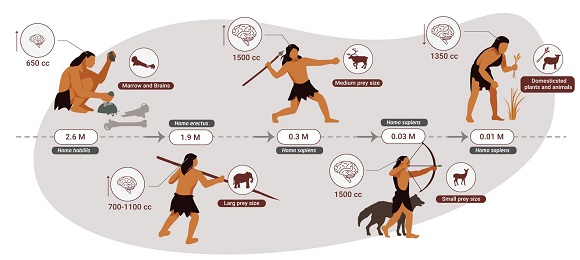 The multidisciplinary reconstruction conducted by TAU researchers for almost a decade proposes a complete change of paradigm in the understanding of human evolution. Contrary to the widespread hypothesis that humans owe their evolution and survival to their dietary flexibility, which allowed them to combine the hunting of animals with vegetable foods, the picture emerging here is of humans evolving mostly as predators of large animals.
“Archaeological evidence does not overlook the fact that stone-age humans also consumed plants,” adds Dr. Ben-Dor. “But according to the findings of this study plants only became a major component of the human diet toward the end of the era.”
Evidence of genetic changes and the appearance of unique stone tools for processing plants led the researchers to conclude that, starting about 85,000 years ago in Africa, and about 40,000 years ago in Europe and Asia, a gradual rise occurred in the consumption of plant foods as well as dietary diversity – in accordance with varying ecological conditions. This rise was accompanied by an increase in the local uniqueness of the stone tool culture, which is similar to the diversity of material cultures in 20th-century hunter-gatherer societies. In contrast, during the two million years when, according to the researchers, humans were apex predators, long periods of similarity and continuity were observed in stone tools, regardless of local ecological conditions.
The multidisciplinary reconstruction conducted by TAU researchers for almost a decade proposes a complete change of paradigm in the understanding of human evolution. Contrary to the widespread hypothesis that humans owe their evolution and survival to their dietary flexibility, which allowed them to combine the hunting of animals with vegetable foods, the picture emerging here is of humans evolving mostly as predators of large animals.
“Archaeological evidence does not overlook the fact that stone-age humans also consumed plants,” adds Dr. Ben-Dor. “But according to the findings of this study plants only became a major component of the human diet toward the end of the era.”
Evidence of genetic changes and the appearance of unique stone tools for processing plants led the researchers to conclude that, starting about 85,000 years ago in Africa, and about 40,000 years ago in Europe and Asia, a gradual rise occurred in the consumption of plant foods as well as dietary diversity – in accordance with varying ecological conditions. This rise was accompanied by an increase in the local uniqueness of the stone tool culture, which is similar to the diversity of material cultures in 20th-century hunter-gatherer societies. In contrast, during the two million years when, according to the researchers, humans were apex predators, long periods of similarity and continuity were observed in stone tools, regardless of local ecological conditions.



